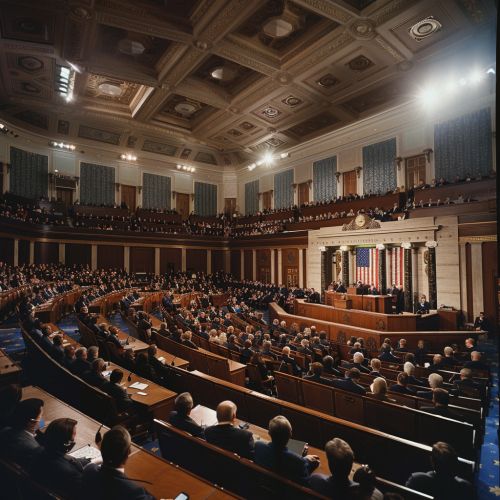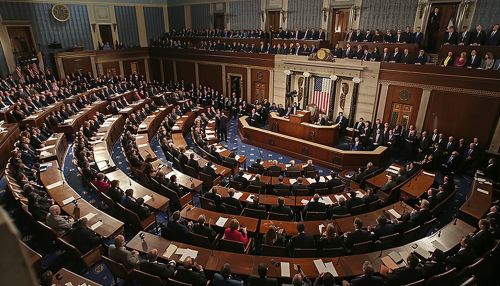Apportionment Act of 1911: Difference between revisions
(Created page with "== Introduction == The Apportionment Act of 1911 was a significant legislative measure in the United States that redefined the distribution of seats in the House of Representatives. This act was pivotal in shaping the modern structure of congressional representation and has had lasting implications on the American political landscape. == Historical Context == The early 20th century was a period of rapid population growth and urbanization in the United States. The Cens...") |
No edit summary |
||
| Line 20: | Line 20: | ||
The Apportionment Act of 1911 had a profound impact on the distribution of political power in the United States. States with rapidly growing populations, such as New York and California, gained additional seats, while states with slower population growth, such as Vermont and Maine, lost seats. This shift in representation reflected the changing demographics of the nation and ensured that the House of Representatives remained responsive to the needs of its constituents. | The Apportionment Act of 1911 had a profound impact on the distribution of political power in the United States. States with rapidly growing populations, such as New York and California, gained additional seats, while states with slower population growth, such as Vermont and Maine, lost seats. This shift in representation reflected the changing demographics of the nation and ensured that the House of Representatives remained responsive to the needs of its constituents. | ||
[[Image:Detail-93341.jpg|thumb|center|The United States House of Representatives chamber, filled with members during a session.|class=only_on_mobile]] | |||
[[Image:Detail-93342.jpg|thumb|center|The United States House of Representatives chamber, filled with members during a session.|class=only_on_desktop]] | |||
== Political Implications == | == Political Implications == | ||
Latest revision as of 09:43, 22 June 2024
Introduction
The Apportionment Act of 1911 was a significant legislative measure in the United States that redefined the distribution of seats in the House of Representatives. This act was pivotal in shaping the modern structure of congressional representation and has had lasting implications on the American political landscape.
Historical Context
The early 20th century was a period of rapid population growth and urbanization in the United States. The decennial census of 1910 revealed significant demographic shifts, necessitating a reevaluation of congressional representation. Prior to the Apportionment Act of 1911, the House of Representatives had been operating under the Apportionment Act of 1901, which was based on the 1900 census.
Legislative Background
The Apportionment Act of 1911 was introduced in response to the need for a more equitable distribution of seats in the House of Representatives. The primary objective was to ensure that each representative would represent a roughly equal number of constituents. This was in line with the principle of "one person, one vote," which aimed to provide fair and equal representation for all citizens.
Key Provisions
The Apportionment Act of 1911 contained several key provisions:
Fixed Number of Representatives
One of the most significant changes introduced by the act was the establishment of a fixed number of representatives. The act set the number of seats in the House of Representatives at 435, a figure that remains unchanged to this day. This fixed number was intended to provide stability and predictability in the apportionment process.
Method of Equal Proportions
The act also introduced the method of equal proportions for apportioning seats among the states. This mathematical formula aimed to minimize the differences in the number of constituents represented by each representative. The method of equal proportions is still used today to allocate seats in the House of Representatives.
Impact on Representation
The Apportionment Act of 1911 had a profound impact on the distribution of political power in the United States. States with rapidly growing populations, such as New York and California, gained additional seats, while states with slower population growth, such as Vermont and Maine, lost seats. This shift in representation reflected the changing demographics of the nation and ensured that the House of Representatives remained responsive to the needs of its constituents.


Political Implications
The Apportionment Act of 1911 had significant political implications. By fixing the number of representatives at 435, the act effectively limited the size of the House of Representatives, preventing it from becoming unwieldy. This decision was not without controversy, as some argued that a larger House would provide more accurate representation.
Impact on Political Parties
The redistribution of seats also had implications for the balance of power between political parties. States that gained seats tended to be more urban and industrialized, which often favored the Democratic Party. Conversely, states that lost seats were often more rural and conservative, which tended to favor the Republican Party.
Long-term Effects
The Apportionment Act of 1911 set a precedent for future apportionment legislation. By establishing a fixed number of representatives and using the method of equal proportions, the act provided a framework that has been used in subsequent apportionment acts. This framework has helped to ensure that the House of Representatives remains a representative and effective legislative body.
Legal Challenges and Reforms
Over the years, the Apportionment Act of 1911 has faced various legal challenges and calls for reform. Critics have argued that the fixed number of representatives does not adequately reflect the growing population of the United States. Some have proposed increasing the number of seats in the House to provide more accurate representation.
Supreme Court Cases
Several Supreme Court cases have addressed issues related to apportionment and representation. Notably, the landmark case of Wesberry v. Sanders (1964) reaffirmed the principle of "one person, one vote" and emphasized the importance of equal representation. The Court ruled that congressional districts must have roughly equal populations, further reinforcing the principles established by the Apportionment Act of 1911.
Calls for Reform
In recent years, there have been renewed calls for reforming the apportionment process. Some advocates argue that the fixed number of 435 representatives is outdated and does not adequately represent the diverse and growing population of the United States. Proposals for reform include increasing the number of seats in the House and adopting alternative methods of apportionment.
Conclusion
The Apportionment Act of 1911 was a landmark piece of legislation that redefined the distribution of seats in the House of Representatives. By establishing a fixed number of representatives and introducing the method of equal proportions, the act ensured that congressional representation remained fair and equitable. Although the act has faced challenges and calls for reform, its principles continue to shape the apportionment process in the United States.
